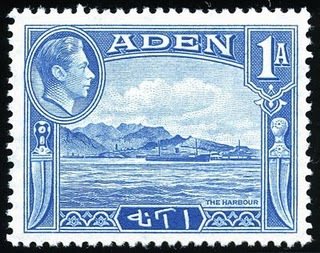Stamp: Harbour of Aden (Aden 1939)
Harbour of Aden (Aden 1939)
19 January (Aden ) within release Definitive goes into circulation Stamp Harbour of Aden face value 1 Indian anna
| Stamp Harbour of Aden in catalogues | |
|---|---|
| Michel: | Mi:AD 18 |
| Yvert et Tellier: | Yt:AD 18 |
Stamp is horizontal format.
Also in the issue Definitive:
- Stamp - Mosque of Aidrus face value ½;
- Stamp - Camel Corps face value ¾;
- Stamp - Harbour of Aden face value 1;
- Stamp - Dhow face value 1½;
- Stamp - Mosque of Aidrus face value 2;
- Stamp - Mukalla Coaling station face value 2½;
- Stamp - Capture of Aden face value 3;
- Stamp - Mukalla Coaling station face value 8;
- Stamp - Dhow face value 1;
- Stamp - Harbour of Aden face value 2;
- Stamp - Camel Corps face value 5;
- Stamp - Capture of Aden face value 10;
|
Data entry completed
90%
|
|
|---|---|
| Stamp Harbour of Aden in digits | |
| Country: | Aden |
| Date: | 1939-01-19 |
| Print: | Recess |
| Size: | 37 x 29 |
| Perforation: | line 12½ |
| Emission: | Definitive |
| Format: | Stamp |
| Face Value: | 1 Indian anna |
Stamp Harbour of Aden it reflects the thematic directions:
A landscape is the visible features of an area of land, its landforms and how they integrate with natural or man-made features. A landscape includes the physical elements of geophysically defined landforms such as (ice-capped) mountains, hills, water bodies such as rivers, lakes, ponds and the sea, living elements of land cover including indigenous vegetation, human elements including different forms of land use, buildings and structures, and transitory elements such as lighting and weather conditions. Combining both their physical origins and the cultural overlay of human presence, often created over millennia, landscapes reflect a living synthesis of people and place that is vital to local and national identity. The character of a landscape helps define the self-image of the people who inhabit it and a sense of place that differentiates one region from other regions. It is the dynamic backdrop to people’s lives. Landscape can be as varied as farmland, a landscape park, or wilderness. The earth has a vast range of landscapes, including the icy landscapes of polar regions, mountainous landscapes, vast arid desert landscapes, islands and coastal landscapes, densely forested or wooded landscapes including past boreal forests and tropical rainforests, and agricultural landscapes of temperate and tropical regions.
A ship is a large watercraft that travels the world's oceans and other sufficiently deep waterways, carrying passengers or goods, or in support of specialized missions, such as defense, research and fishing. Historically, a "ship" was a sailing vessel with at least three square-rigged masts and a full bowsprit. Ships are generally distinguished from boats, based on size, shape and load capacity.
King is the title given to a male monarch in a variety of contexts. The female equivalent is queen regnant (while the title of queen on its own usually refers to the consort of a king). In the context of prehistory, antiquity and contemporary indigenous peoples, the title may refer to tribal kingship. Germanic kingship is cognate with Indo-European traditions of tribal rulership (c.f. Indic rājan, Gothic reiks, and Old Irish rí, etc.) In the context of classical antiquity, king may translate Latin rex or either Greek archon or basileus. In classical European feudalism, the title of king as the ruler of a kingdom is understood as the highest rank in the feudal order, potentially subject, at least nominally, only to an emperor (harking back to the client kings of the Roman Empire). In a modern context, the title may refer to the ruler of one of a number of modern monarchies (either absolute or constitutional). The title of king is used alongside other titles for monarchs, in the West prince, emperor, archduke, duke or grand duke, in the Middle East sultan or emir; etc. Kings, like other royalty, tend to wear purple because purple was an expensive color to wear in the past.
Coastal areas are local administrative units (LAUs) that are bordering or close to a coastline. A coastline is defined as the line where land and water surfaces meet (border each other).




